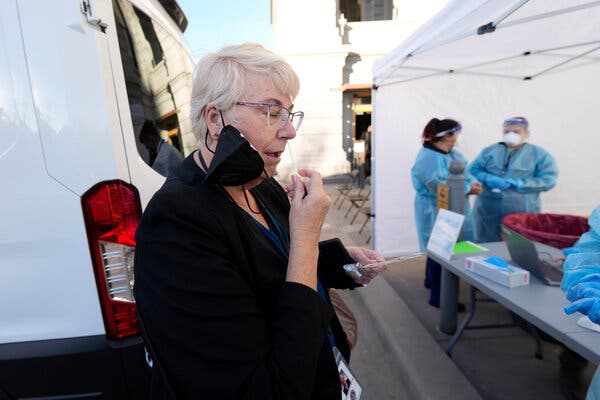The Centers for Disease Control and Prevention shifted its guidelines on Friday to say that fewer communities were in need of coronavirus restrictions such as masks and social distancing, a change that coincided with moves by several states to drop such protections.
But the rush to return to normality in light of an improving national outlook for coronavirus cases has many public health experts concerned that the end of the Omicron surge is incorrectly being conflated with the end of the pandemic.
“Things are improving, but we still aren’t at a point where we’re getting out in front of this,” said Dr. Lynn R. Goldman, dean of the Milken Institute School of Public Health at George Washington University.
Dr. Goldman said the new C.D.C. guidance was comparable to an “off ramp” from the pandemic, even though new variants could still emerge and the country’s health system, and public, is not equipped for another surge in cases.
The daily average number of coronavirus cases has dropped 63 percent and the average number of hospitalizations has dropped 44 percent in the United States over the past 14 days, according to a New York Times database, continuing a steady trend of declining coronavirus numbers nationally. The daily average number of deaths is still roughly 1,900 — a 23 percent drop over the past two weeks — but that is expected to fall further soon because of the lag between hospitalization and death rates.
The new C.D.C. guidelines encourage counties to not just use case rates to calculate the risk for communities, but also include hospitalization figures. This change suggests that 70 percent of Americans could now stop wearing masks, and stop social distancing or avoiding crowded indoor spaces.
Several experts said that the new C.D.C. guidelines were appropriate, but many have expressed concern that the recommendations do not account for the unknowns of the pandemic.
Dr. Gerald E. Harmon, the president of the American Medical Association, said in a statement in response to the new recommendations that he would continue to wear a mask “in most indoor public settings,” and he urged all Americans to do the same. “We must remain adaptable and vigilant in confronting this unpredictable virus,” Dr. Harmon said.
The C.D.C. guidance came after several states, including Illinois, Connecticut and New York, made moves to end or phase out mask mandates.
In Colorado, Gov. Jared Polis said on Friday that the state would end its coronavirus emergency response and that residents had “earned the right to move beyond the pandemic in your lives.”
“There is no claiming victory with regards to the virus,” Mr. Polis said. “The virus is here and will likely be here for the rest of our lives. But it is time to acknowledge that we have reached a point in Colorado where Coloradans who are fully vaccinated can freely live without undue fear.”
Also on Friday, Gov. Gavin Newsom of California lifted 19 executive actions related to the pandemic and said another 18 would be lifted on March 31, although its emergency declaration remains in place.
Dr. Rochelle Walensky, the C.D.C.’s director, was asked in a call with reporters on Friday about the timing of the new guidance and how it related to decisions by states to drop restrictions.
She said that the agency had been planning to shift the metric to hospitalizations for some time and that many state policies “will coincide with exactly what we are recommending.”
Dr. Esther Choo, an emergency medicine physician at the Oregon Health and Science University, said on Twitter that making hospitalizations the sole metric “means allowing a high burden of disease & having a delayed response that is slow to have impact on hospitalizations and death.”
Dr. Goldman, of the Milken Institute, shared the same concern and said that the current lull in infections should be used as an opportunity to prepare, including by ensuring that people have access to surgical masks instead of the less effective cloth masks and by improving testing resources in communities.
“The desire to walk away from this cannot just be that we are going to forget about it and fail to prepare for the next one,” Dr. Goldman said.


























